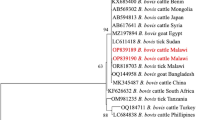Abstract
Filaria martis causes a poorly known subcutaneous filariosis in mustelids. Few information is available about lesions that F. martis causes in beech martens, on its morphology, biology and the occurrence of the infection. From 1997 to 2006, 29 beech martens from two sites of southern Italy (Sites A and B) have been necropsied. Ectoparasites and nematodes were collected and morphologically identified. A variable region of the cytochrome c oxidase subunit 1 (cox1) of F. martis has been characterised to compare females presenting caudal tips smooth without spines (i.e. Morphotype 1—Mrph. 1) and with spines (i.e. Mrph. 2). All ticks collected were identified as Haemaphysalis erinacei. Eleven animals from Site A were found infected by F. martis nematodes in subcutaneous tissue in both membranous capsules or free under the inner skin surface. The most important morphological characters of F. martis have been reported and discussed. The molecular analysis showed 100% homology among cox1 sequences from Mrph. 1 and 2 thus indicating that the shape of female posterior edge may vary among specimens of F. martis. The results here presented provide new insights into the biology, ecology and morphological characteristics of this scantly known nematode.






Similar content being viewed by others
References
Anderson RC (1960) A study of Filaria martis Gmelin 1790, from Martes foina and Pedetes caffer. Can J Zool 38:157–167
Anderson RC (1997) Acute filariasis in a Springhaas. J Wildl Dis 34:157–167
Anderson RC (2000) Nematode parasites of vertebrates. Their development and transmission. CABI Publishing, Guilford, UK
Anderson TJC, Blouin MS, Beech RN (1998) Population biology of parasitic nematodes: applications of genetic markers. Adv Parasitol 41:219–283
Baumann R (1946) Beobachtungen beim parasitaren sommerblten der Pferde. Wein Tierarztl Monatschr 33:52–55
Casiraghi M, Anderson TJC, Bandi C, Bazzocchi C, Genchi C (2001) A phylogenetic analysis of filarial nematodes: comparison with the phylogeny of Wolbachia endosymbionts. Parasitology 122:93–103
Chabaud AG, Mohammad K (1989) Le genre Filaria Gmelin 1790. Description de quatre espèces nouvelle. Bull Mus Nat Hist Nat 11:47–59
Gasser RB, Newton SE (2000) Genomic and genetic research on bursate nematodes: significance, implications and prospects. Int J Parasitol 30:509–534
Hu M, Gasser RB, Abs El-Osta YG, Chilton NB (2003) Structure and organization of the mitochondrial genome of Dirofilaria immitis. Parasitology 127:37–51
Hu M, Chilton NB, Gasser RB (2004) The mitochondrial genomics of parasitic nematodes of socio-economic importance: recent progress, and implications for population genetic and systematic studies. Adv Parasitol 56:131–209
Keddie EM, Higazi T, Unnasch TR (1998) The mitochondrial genome of Onchocerca volvulus: sequence, structure and phylogenetic analysis. Mol Biochem Parasitol 95:111–127
Keppner EJ (1969) Filaria taxideae n. sp. (Filarioidea: Filariidae) from the badger Taxidea taxus taxus from Wyoming. Trans Am Microsc Soc 88:581–588
Lovari S, Rolando A (2004) Guida allo studio degli animali in natura. Ed. Bollati Bolinghieri, Torino
Manilla G (1998) Fauna d’Italia Vol. XXXVI Acari-Ixodida. Ed. Calderini, Bologna
Otranto D, Testini G, Deluca F, Hu M, Shamsi S, Gasser RB (2005) Analysis of genetic variability within Thelazia callipaeda (Nematoda: Thelazioidea) from Europe and Asia by sequencing and mutation scanning of mitochondrial cytochrome c oxidase subunit 1. Mol Cell Probes 19:306–313
Stiles CW (1907) The zoological characters of the round-worm genus Filaria Mueller 1787, with a list of thread worms reported from man. US Public Health and Marine-Hospital Serv. Hyg Lab Bull 34:31–51
Thompson JD, Gibson TJ, Plewniak F, Jeanmougin F, Higgins DG (1997) The Clustal X windows interface: flexible strategies for multiple sequence alignment aided by quality analysis tools. Nucleic Acids Res 24:4876–4882
Worley DE (1961) The occurrence of Filaria martis Gmelin, 1790, in the striped skunk and badger in Kansas. J Parasitol 47:8–10
Acknowledgment
The authors wish to dedicate this work in memory of Prof. Roy Anderson who kindly provided suggestions at the beginning of this research.
Author information
Authors and Affiliations
Corresponding author
Rights and permissions
About this article
Cite this article
Otranto, D., Lia, R.P., Cantacessi, C. et al. Filaria martis Gmelin 1790 (Spirurida, Filariidae) affecting beech marten (Martes foina): morphological description and molecular characterisation of the cytochrome oxidase c subunit I. Parasitol Res 101, 877–883 (2007). https://doi.org/10.1007/s00436-007-0554-3
Received:
Accepted:
Published:
Issue Date:
DOI: https://doi.org/10.1007/s00436-007-0554-3




